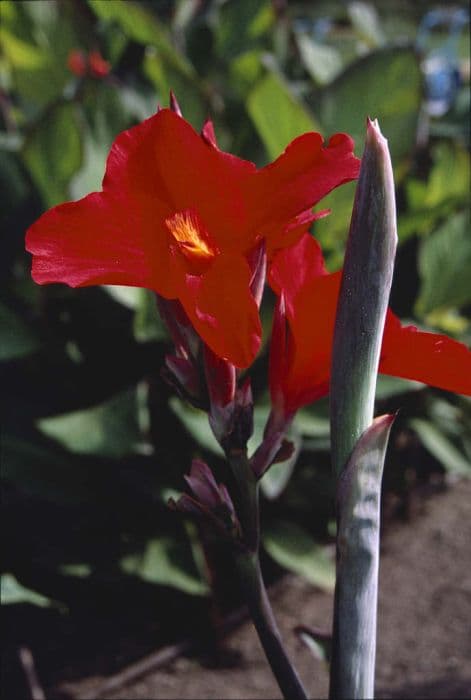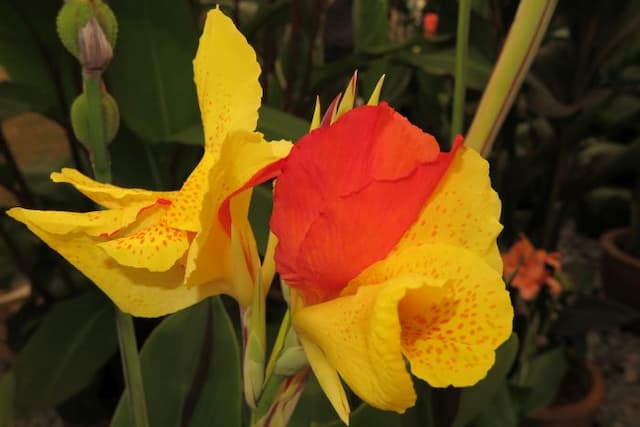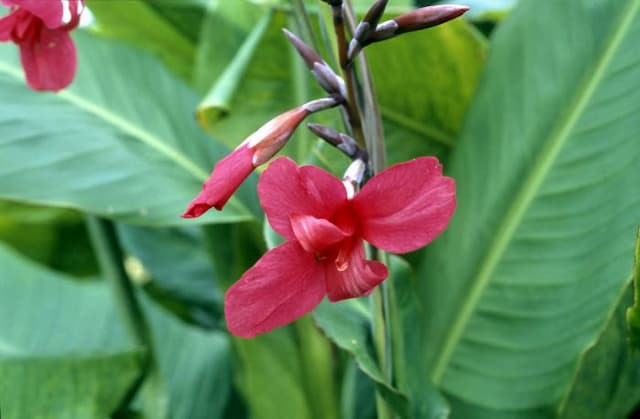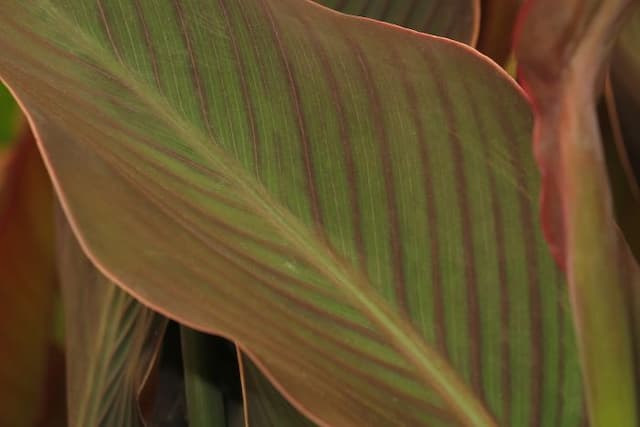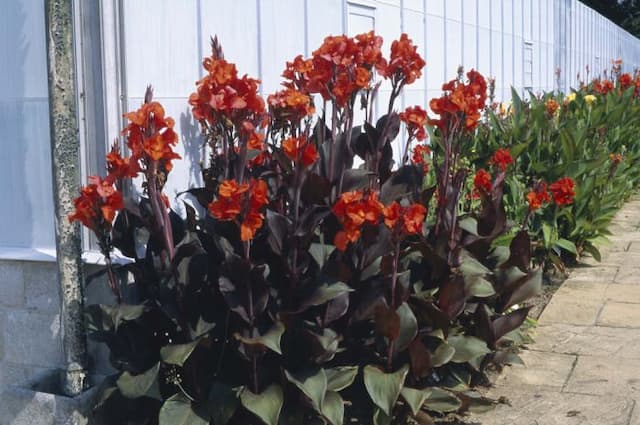Canna 'Russian Red' Canna indica 'Russian Red'

ABOUT
'Russian Red' is a striking foliage plant growing to 2.9m tall, with spreading, reddish-bronze leaves and pink-flushed orange flowers from late summer
About this plant
 Names
NamesFamily
Cannaceae.
Synonyms
Indian Shot, African Arrowroot, Sierra Leone Arrowroot, Russian Red Canna.
Common names
Canna edulis, Canna compacta, Canna achiras, Canna coccinea, Canna esculenta, Canna lutea, Canna pentaphylla, Canna sanguinea, Canna viridiflora.
 Characteristics
CharacteristicsLife cycle
Perennials
Foliage type
Deciduous
Color of leaves
Reddish-green
Flower color
Red
Height
3-4 feet (0.9-1.2 meters)
Spread
1-2 feet (0.3-0.6 meters)
Plant type
Herb
Hardiness zones
7
Native area
South America
Benefits
 General Benefits
General Benefits- Ornamental Value: Canna indica 'Russian Red' has striking red flowers, providing a vivid splash of color to any garden.
- Drought Tolerance: It can withstand periods of low water, making it suitable for xeriscaping and low-water gardens.
- Wildlife Attraction: The flowers can attract hummingbirds and butterflies, enhancing the biodiversity of the garden.
- Soil Improvement: The plant can help to prevent soil erosion and improve soil structure over time.
- Easy Maintenance: It requires minimal care once established, making it a good choice for both novice and experienced gardeners.
- Rapid Growth: The plant grows quite quickly, which can be advantageous for creating a full garden display in a short period.
 Medical Properties
Medical Properties- This plant is not used for medical purposes.
 Air-purifying Qualities
Air-purifying QualitiesThis plant is not specifically known for air purifying qualities.
 Other Uses
Other Uses- Canna indica 'Russian Red' can be used for making natural dyes for textiles, providing a range of colors depending on the part of the plant used.
- The leaves of Canna indica 'Russian Red' are large and waterproof, and locals in some regions use them as temporary umbrellas or wrappers for food.
- The seeds of Canna indica 'Russian Red' are hard and bead-like; they can be used in jewelry making or as a natural replacement for plastic or glass beads in crafts.
- Starch extracted from the rhizomes of Canna indica 'Russian Red' can be used as a biodegradable alternative to Styrofoam or other non-eco-friendly packing materials.
- The Canna indica 'Russian Red' can be planted as a biomass crop; the fast-growing nature of the plant makes it an excellent candidate for renewable energy sources.
- Fiber from the stems and leaves can be used to make paper, offering a sustainable alternative to traditional wood pulp paper production.
- The long sturdy stalks of Canna indica 'Russian Red' can be dried and used as natural supports for climbing plants or within vegetable gardening.
- Dried flowers and foliage from Canna indica 'Russian Red' can be incorporated into potpourri mixtures for natural home fragrances.
- Because of their vibrant color and unique texture, the flowers and leaves can be used in artistic installations, acting as natural art materials.
- Bio-filters using Canna indica 'Russian Red' can be created for treating wastewater due to the plant's ability to uptake and assimilate nutrients and contaminants.
Interesting Facts
 Feng Shui
Feng ShuiIndian Shot is not used in Feng Shui practice.
 Zodiac Sign Compitability
Zodiac Sign CompitabilityIndian Shot is not used in astrology practice.
 Plant Symbolism
Plant Symbolism- Exuberance – The vibrant red of the Canna indica flowers and their lush foliage symbolize a full and vibrant life, often exuding energy and vitality.
- Fertility – With its robust growth habits, the plant is often used to represent fertility and the ability to flourish in various conditions.
- Change – The regular cycle of growth, blooming, and dormancy in Cannas can symbolize the nature of change and transformation in life.
- Beauty – The striking appearance of Canna indica 'Russian Red' embodies beauty and appreciation for the aesthetic pleasures in the world.
 Water
WaterThe Canna Lily, commonly known as Russian Red, should be watered when the top inch of soil feels dry to the touch. In the absence of rainfall, this typically means watering once a week with about one to two gallons of water, depending on the size of the plant and the environmental conditions. During hot or windy weather, they may need water more frequently, and less often when the weather is cool or overcast. It’s important to water deeply and slowly, so the water reaches the root zone. Be cautious not to overwater, as the Canna Lily does not like to sit in waterlogged soil.
 Light
LightThe Canna Lily thrives in full sun, requiring at least 6 to 8 hours of direct sunlight each day for optimum growth and blooming. An ideal spot for this plant is in a garden bed or container that receives unhindered sunlight throughout the day. Avoid placing it in deep shade as this will impede its growth and reduce flowering.
 Temperature
TemperatureThe Canna Lily prefers warm temperatures and grows best when the climate is between 60°F and 90°F. While it can survive minimum temperatures down to about 50°F, frost can cause damage to the plant. The ideal temperature range promotes healthy foliage and vibrant blooms.
 Pruning
PruningPrune the Canna Lily to remove spent flowers and dead foliage, which encourages new growth and more blooms. Pruning can be done throughout the growing season as needed. The best time to do a major pruning is in late winter or early spring before new growth begins, removing old growth and shaping the plant.
 Cleaning
CleaningAs needed
 Soil
SoilThe Canna Lily 'Russian Red' thrives in a well-draining, fertile soil mix rich in organic matter. A balanced mixture could be composed of equal parts peat, compost, and perlite or sand. This plant prefers a slightly acidic to neutral soil pH ranging from 6.0 to 6.5. Regular applications of a slow-release fertilizer will benefit its growth and flowering.
 Repotting
RepottingCanna Lily 'Russian Red' should be repotted every 2 to 3 years to refresh the soil and accommodate root growth. Divide the rhizomes during repotting to propagate or manage the plant's size. The repotting is best done in the spring just before the growing season begins.
 Humidity & Misting
Humidity & MistingCanna Lily 'Russian Red' is tolerant of a range of humidity levels but prefers moderate to high humidity. Aim for a humidity level between 40% and 70% for optimal health and growth.
 Suitable locations
Suitable locationsIndoor
Place in bright, indirect light with ample space.
Outdoor
Plant in full sun with moist, fertile soil.
Hardiness zone
8-11 USDA
 Life cycle
Life cycleThe life of Canna 'Russian Red', often known as Indian Shot, begins with seed germination, where the hard seed coat breaks and the embryonic plant emerges, provided it's been scarified and exposed to warm, moist conditions. Next, the seedling develops into a juvenile plant, characterized by the growth of a rhizome and the emergence of distinctive foliage and stems. As the plant matures, it enters the vegetative state, during which it continues to expand in size and produce larger leaves and stronger stems. Once environmental conditions are favorable, such as in the spring or summer, the Indian Shot enters the flowering stage, producing vibrant red flowers that attract pollinators. After pollination, the flowers will set seeds enclosed in capsules, completing the reproductive phase. Lastly, the plant may enter a period of dormancy, particularly in cooler climates, where the above-ground foliage dies back and the rhizome remains dormant underground until the following growing season.
 Propogation
PropogationPropogation time
Spring-Early Summer
The Canna Lily 'Russian Red' is typically propagated by dividing its rhizomes, which is the most popular method for this species. The best time to divide the rhizomes is in spring when the plants are coming out of dormancy, or in the fall after the foliage has died back. To propagate, one should gently lift the clump of rhizomes out of the ground using a shovel. The soil is then carefully removed, and the rhizomes are divided by cutting them with a sharp knife, making sure each section has at least one eye or bud. These sections can then be replanted immediately at a depth of about 3 to 4 inches (7.6 to 10.2 centimeters) and spaced approximately 12 to 18 inches (30.5 to 45.7 centimeters) apart to allow adequate room for growth. It's essential to keep the newly planted rhizomes well-watered until they are established.

